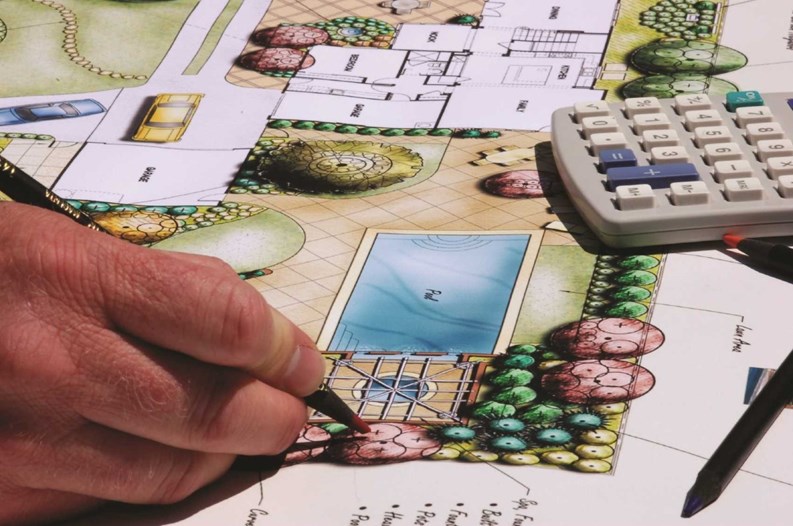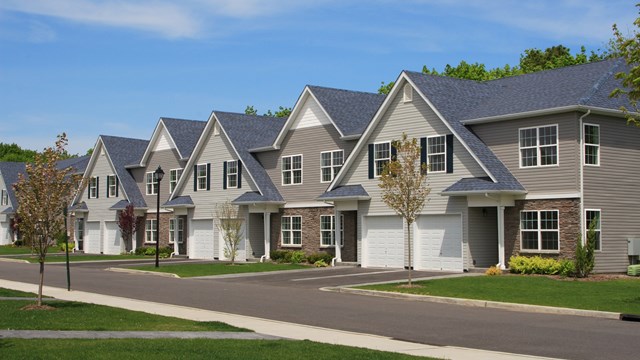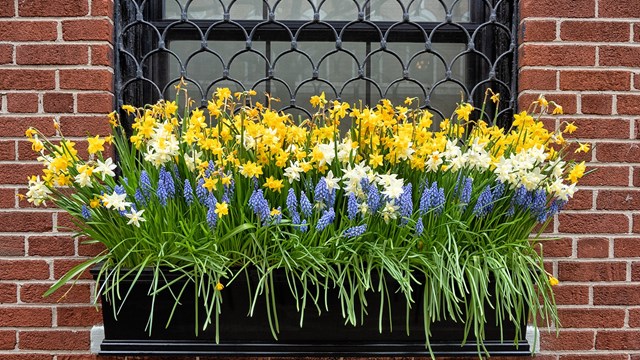Chestertowne Townhouses, located on Main Street in Chester, New Jersey, needed their landscaping spruced up a bit, so when it came time for the company they hired to do the job, Parsippany-based Davies Associates Landscape Architects LLC to design a fresh plan, Davies decided that personalization was key.
“This was a group of about 24 large units where the homeowners had all owned houses before, so we designed custom plantings for each unit to suit their tastes individually,” says Bruce John Davies, ASLA, and president of Davies Associates. “The project benefited everyone as a whole.”
Unless it’s totally wild, almost all the topography and plantings at an HOA have been designed by a company or individual, typically a landscape architect like Davies. According to the U.S. Department of Labor, a landscape architect is, in most states, licensed with: a degree in landscape architecture from an accredited school, work experience, and the passage of the Landscape Architect registration exam.
As of January 2008, 49 states required landscape architects to be licensed. The Landscape Architect Registration Examination is sponsored by the Council of Landscape Architectural Registration Boards and admission to the exam usually requires a degree from an accredited school, plus one to four years of work experience under the supervision of a licensed landscape architect, although standards vary from state to state. Currently, 15 states require a state examination to be passed in addition to the exam to satisfy registration requirements. State examinations focus on laws, environmental regulations, plants, soils, climate, and any other characteristics unique to the state.
Why Go Professional?
But why hire a landscape architect when your association may have a super or groundskeeper on staff who can just as easily mow the lawn and plant some flowers? That’s easy. Poor landscaping, unkempt flowers, scruffy shrubbery, and trees desperate of a pruning will push potential homebuyers away, and may ruffle the feathers of current unit owners who have a financial investment at stake and want the property to look good. This, in turn, will directly affect the association’s bottom line.
Think about what the prospective buyer might see when they come by to check out a unit. Perhaps the super has some landscaping knowledge and might be able to put together a nice garden, but it is probably not his or her specialty.
“The right design will make the value of the property grow—and people who are happy with their environment will have pride in it,” says Dean Carpenter of Houston Landscapes Unlimited, based in Sugarland, Texas.
That said, matching the right landscape architect to the property’s needs and tastes is like dating—it’s important to check out a few candidates and see what they can bring to the table before committing. If budget is a factor, it’s important to hire only as much expertise as is needed. There are landscape designers, garden consultants and master gardeners, but they each bring a different level of expertise to the project. Not sure where to start or what needs to be done? A landscape architect might be exactly what is needed.
“If they are looking for a good fit they will want a firm with experience in projects similar to their own association’s property,” says Davies. “They also look for a comfortable personality and someone who will show basic courtesies, like returning phone calls promptly.”
The New Jersey Landscape
In New Jersey, a great place to start looking for a landscape architect is the American Society of Landscape Architects (www.asla.org). According to the website, it was founded in 1899 and is the national professional association representing landscape architects. Beginning with 11 original members, ASLA has grown to more than 18,000 members and 48 chapters, representing all 50 states, U.S. territories, and 42 countries around the world. ASLA promotes the landscape architecture profession and advances the practice through advocacy, education, communication, and fellowship.
There is a list of New Jersey landscape architects on the website. Just click on “Products and Services” at the top of the page and then click on “Firm Finder.” Select “New Jersey” and there will be a list of landscape architects located in that area.
As with many businesses, word-of-mouth is another great way of getting recommendations. Check out other properties in your neck of the woods, and if their landscape is attractive, suitable and cared for, ask their management for a recommendation. Then, check out the landscaping company by looking on their website, scheduling a consultation, calling other clients for additional testimonials and, finally, seeing a portfolio of their previous work.
“Usually boards interview two or three local firms and discuss design approaches as well as fee structures,” says Davies. “Once a firm is hired, they can help guide the process through schematic designs to construction drawings. Then they can help to get bids from good landscape contractors who have positive reputations, and the landscape architects can oversee the construction phase.”
Clear Expectations
It’s vital for the board to establish a clear understanding of what is expected from a landscape architect and make sure to communicate this to those who are interviewed. Does the property need a complete overhaul of an outdated or boring landscape? Will there be color added, or does the property only need trees and shrubbery? Will there be special lighting, statues or designs? Do some basic research by visiting other properties or looking on the Internet for design ideas before the first meeting.
Once a landscape architect is chosen, they will study a project, and consider various factors into their designs including budget, climate, soil, slope of the land, drainage, vegetation, sunlight and existing buildings, roads, walkways, and utilities.
“If it’s a raw site, the landscape architect works with the building architect and we look at the topography, solar gain, trees, and so forth,” says Thomas Tavella, ASLA, vice president of the BSC-Group, in Glastonbury, Connecticut. “If it’s an existing development we’ll look at the perimeter of how the house sits, the trees that are there and existing living space or pools on the property.”
Then they prepare a preliminary design and meet with the client to determine if changes are going to be made. To address the needs of the client as well as the conditions at the site, they frequently make changes before a final design is approved. They also take into account any local, state, or federal regulations, such as those protecting wetlands or historic resources.
Landscape architects use CAD, or computer-aided design, programs in their design and some use video.
Throughout all phases of planning and design, landscape architects consult with other professionals, such as civil engineers, hydrologists, or architects involved in the project. Once the design is complete, they prepare a proposal for the client.
“Cost is always a concern,” says Davies. “HOAs must plan to budget enough money to cover the design fees and a good construction fee. The landscape architect can help by preparing a construction budget once the schematic design has been prepared and approved. The landscape architect’s design fees will usually run from 12 to 18 percent of the construction costs. Planting costs can vary with the size of the plant material used. Smaller plants cost less, but take time to grow. Larger plants have a bigger impact from the start.”
Interestingly, in a real estate market that is suffering, property managers still recognize the importance of keeping the landscaping pristine. According to a survey by ASLA, the majority of landscape architects remain busy despite trouble in the housing market. More than six in 10 firms reported steady or increased work, and nearly four in 10 firms planned to hire in the upcoming quarter. The survey asked quarterly benchmarks on key statistics including billable hours, inquiries, and hiring plans, with 319 firms responding.
Once the project is done and the landscape architect has left the property, then what? Who maintains the landscape?
“Maintenance should be discussed from the start,” says Davies. “The ASLA can provide written maintenance guidelines for contractors to follow. Common problems include pruning shrubs too severely, over mulching, and getting proper irrigation on the plantings. The landscape should look natural, not heavily pruned, and using mostly native plants will keep maintenance costs down, because they have a higher survival rate.”
As with anything, be it plumbing, lighting, or construction, it’s vital to consult with a reputable, qualified professional when planning or updating your HOA’s landscape design and maintenance scheme.
Lisa Iannucci is a freelance writer and author living in Poughkeepsie, New York.







Leave a Comment